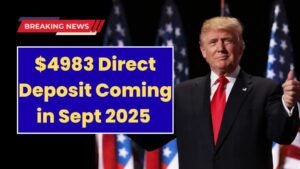What if your bank account received an unexpected $1,390 direct deposit this September? For millions of Americans, that fantasy may soon be reality. The IRS has confirmed a new relief rollout, and knowing the rules could be the difference between missing out or cashing in big.
What Is the $1390 IRS Direct Deposit Relief?
The $1,390 direct deposit relief is part of a federal assistance program designed to help households manage rising living costs in 2025. It’s a one-time payment, issued directly into eligible taxpayers’ bank accounts. Unlike tax refunds, this relief comes separately — meaning you don’t have to wait until tax season to see it.
A Brief History: Where Did This Relief Come From?
The IRS has a long history of distributing financial aid during economic strain. From the 2008 stimulus checks to the 2020 pandemic relief payments, direct deposits have been used to stabilize families and stimulate the economy. The September 2025 payout follows this tradition, targeting citizens most impacted by inflation and rising daily expenses.
Key IRS Relief Payments Over the Years
| Year | Amount Issued | Reason for Relief |
|---|---|---|
| 2008 | $600+ | Recession Stimulus |
| 2020 | $1,200+ | COVID-19 Pandemic |
| 2021 | $1,400 | Economic Recovery |
| 2025 | $1,390 | Cost-of-Living Aid |
Why This Relief Matters in 2025
Inflation has chipped away at purchasing power, making essentials like groceries, fuel, and rent more expensive. The $1,390 direct deposit isn’t just cash — it’s breathing room. For many, it can cover a month’s rent, utility bills, or emergency expenses. This relief is more than money; it’s stability at a critical moment.
Who Is Eligible for the $1390 Relief?
Eligibility depends on income, filing status, and tax history. The IRS typically prioritizes low to middle-income households. Direct deposit details already on file with the IRS will be used for speed.
Estimated Eligibility Guidelines
| Filing Status | Income Threshold | Expected Payout |
|---|---|---|
| Single Filers | Up to $75,000 | Full $1,390 |
| Married (Joint) | Up to $150,000 | Full $2,780 |
| Head of Household | Up to $112,500 | Full $1,390 |
| Above Thresholds | Phase-Out Begins | Reduced Amount |
How to Claim or Confirm Your Payment
- Check IRS.gov — Updates on payment schedules are published directly.
- Verify Bank Info — Ensure your direct deposit details are current.
- File Taxes On Time — Even if you earn little, filing ensures eligibility.
- Watch for IRS Notices — Letters will confirm your payment status.
Eye-Opening Facts About IRS Relief Payments
- Over 85% of households received stimulus payments in 2020.
- Direct deposit payments typically arrive 2–3 weeks earlier than mailed checks.
- Billions go unclaimed each year due to outdated tax filings or missed eligibility.
Expert Tips to Maximize Your Relief
- Use the Payment Wisely — Prioritize essentials before splurging.
- Set Aside for Emergencies — A savings cushion reduces future stress.
- Avoid Scams — The IRS never calls or emails asking for bank details; payments are automatic.
FAQs
Q: Do I need to apply for the $1,390 payment?
A: No, payments are automatic if you’re eligible and filed taxes.
Q: When will the money arrive?
A: Deposits are expected to roll out in mid-to-late September 2025.
Q: What if I don’t have direct deposit set up?
A: Paper checks will be mailed, though they may take longer to arrive.
Conclusion: Don’t Miss the $1390 Opportunity
The IRS $1,390 direct deposit relief for September 2025 is more than a headline — it’s a lifeline. For many households, it means financial relief when it’s needed most. Stay informed, check your eligibility, and make sure your banking info is current. Your account could be next to receive this hidden boost.




